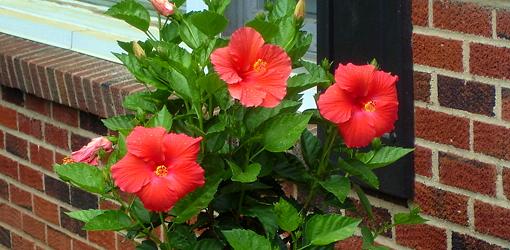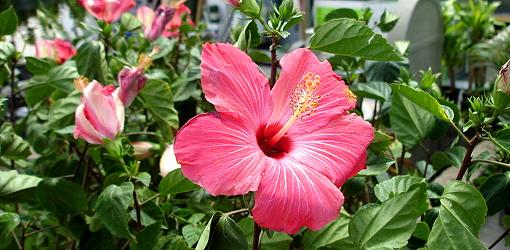How To Stake Hibiscus Garden

Tropical hibiscus makes a great summer container plant.
The large, colorful blossoms of Hibiscus (Hibiscus sp.) create an eye-catching display during summer, attracting hummingbirds and butterflies and providing the look of a tropical paradise, no matter what the variety. Hibiscus plants are members of the Mallow family, and there are many different species that are used in gardening, agriculture, and manufacturing.
To grow hibiscus in your home garden, it's important to know the three main types of plants:
- Tropical hibiscus
- Hardy perennial hibiscus
- Hardy shrub hibiscus
Here are some tips for growing and caring for all three.
Tropical Hibiscus

With its sturdy shape and colorful blossoms, tropical hibiscus (Hibiscus rosa-sinensis) is a popular choice for container plants and tropical gardens. It grows as a small shrub or tree, with stiff woody stems and thick, glossy, dark green leaves.
Blossoms are usually 3"- 6" in diameter and come in many different colors and varieties including red, orange, yellow, salmon-pink, multicolored, and even double blossoms.
How to Grow Tropical Hibiscus
- Climate: Can be grown year round in zones 9-10 but will not survive frost or heavy freeze. Cooler zones (8 and lower) usually grow it as an annual, or in containers that can be brought indoors during cold weather.
- Light: Full sun.
- Soil: Rich and well-draining. Container-grown plants are often grown in a soilless potting medium to prevent compaction. Keep moist, but don't let it stand in water.
- Fertilizer: Tropical hibiscus blooms on new growth, so it benefits from regular feeding with a balanced, organic, liquid fertilizer.
- Flowers: Blooms spring through fall, but flowering may slow in the heat of midsummer.

To keep your tropical hibiscus over the winter, bring it indoors before night temperatures fall into the 40s F. Keep in a cool, bright spot (55°-70° F). Reduce, but don't discontinue, watering. Your plant may lose some leaves as it adjusts to the change.
A few weeks before moving outdoors in the spring, give your hibiscus a rather heavy pruning – shortening leggy stems and removing rubbing branches. Remove the top couple of inches of soil and replace with fresh compost. Add some organic fertilizer, and your plant will be well on its way to a spring growth spurt!
Some varieties of tropical hibiscus overwinter better than others. If yours doesn't bloom well the second year, you may want to consider replacing it.
Hardy Perennial Hibiscus

If you look at your local garden center for winter-hardy hibiscus, chances are you'll find the enormous dinner-plate-sized blossoms of Hibiscus moscheutos. Commonly called Rose Mallow or Swamp Mallow, this plant is an herbaceous perennial, which means it will die completely back to the ground in the winter then sprout anew in the spring.
Compared to tropical hibiscus, the stems and heart-shaped leaves of hardy hibiscus are much softer, dull green, and tender. Blossoms are usually flat and large and the texture of tissue paper. They are available in colors of red, pink, and white.
How to Grow Hardy Perennial Hibiscus
- Climate: Hardy to Zone 4. Does not transplant very well, so choose your location carefully.
- Light: Full Sun.
- Soil: Well-draining and rich. Loves water and should remain moist in summer. Grows naturally near ditches and swamps. During the winter, however, the roots should not be soggy. Add mulch to hold in moisture and prevent damage from late spring frosts.
- Fertilizer: Hardy hibiscus is a heavy feeder. Organic fertilizers with plenty of phosphorus will encourage blooms.
- Flowers: Blooms in July and August. Each flower is short-lived, but there are plenty more to come.

In the fall or late winter, cut back the dead stems of hardy hibiscus to near ground level. Compared to other perennials, this plant can be a little late to sprout in the spring, but by midsummer it will be sprawling several feet high. Stake long stems if needed.
In addition to Hibiscus moscheutos, other perennial hibiscus species include the slender petals of Scarlet Hibiscus (Hibiscus coccineus) and the ruffled pink blossoms of Confederate Rose (Hibiscus mutabilis). If you live near water, try growing the marsh-loving Giant Rose Mallow (Hibiscus grandiflora).
Hardy Hibiscus Shrubs: Althea or Rose of Sharon

Last, but certainly not least, we come to the larger shrubs and trees known more commonly as Althea or Rose-of-Sharon (Hibiscus syriacus). These carefree plants brighten up any landscape and are a must-have for hummingbird and butterfly gardens. The blooms are smaller than its tropical cousin, but it has a sustained, prolific bloom period in mid to late summer.
Hibiscus syriacus is a deciduous shrub or small tree, growing up to 10 feet tall and wide, with dark green foliage and flowers in shades of pink, blue, lavender, and white.
How to Grow Hardy Hibiscus Shrubs
- Climate: Grown in zones 5-9. Used as a border or specimen shrub. Loses its leaves in winter. Upright shape, fairly dense, with a coarse texture.
- Light: Full sun, with a little afternoon shade in hotter climates.
- Soil: Rich and well-draining, although it's pretty adaptable to a range of growing conditions.
- Fertilizer: Average water and nutrient needs. Generally carefree.
- Flowers: A rapid grower that can be pruned heavily in the early spring to encourage larger blossoms. May self-seed and sprout around the base.


White Althea
Further Information
- How to Grow Swamp Hibiscus (article)
- Problem with Tropical Hibiscus Leaves Turning Yellow (article)
- How to Spruce Up a Summer Garden with Tropical Plants (article)
The website floridata.com has excellent specific growing instructions for many varieties of hardy hibiscus including:
- Scarlet Hibiscus
- Confederate Rose
- Swamp Rose Mallow
More information about the many varieties of tropical hibiscus can be found at www.trop-hibiscus.com.
How To Stake Hibiscus Garden
Source: https://todayshomeowner.com/how-to-grow-hibiscus/
Posted by: coopertherof.blogspot.com

0 Response to "How To Stake Hibiscus Garden"
Post a Comment